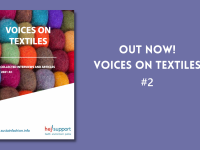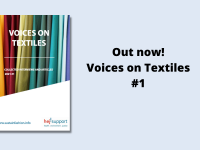The Health Effects of Viscose Production

In 2019, viscose alone accounted for 79% of the global market share of man-made cellulosic fibers, which are sourced from plant-based materials.1 Additionally, the compound annual growth rate for viscose was projected to be between 6 and 7% from the time period of 2017 to 2022.1 Although the adverse environmental impacts of this popular material are well known, the health impacts regarding viscose production need further examination and attention.
In the early stages of its lifecycle, viscose has been associated with health risks endured by workers due to the exposure to chemicals used in the extraction and further processing of cellulose.2 One of these hazardous chemicals is sodium hydroxide, which is highly corrosive and causes severe skin burns and damage eyes with direct contact.2 Another chemical known as carbon disulfide, which is used to spin cellulose into viscose fibers, also has significant associated health risks including coronary heart disease, psycho-physiological and central nervous system effects, retinal angiopathy and many others.2,3 Research has shown that chronic exposure to carbon disulfide particularly in female workers may also result in increased frequency of hormonal disturbances, resulting in menstrual disorders, early menopause and more.4
Despite the persistence of health risks to workers, viscose production continues undeterred as it is considered safe to wear viscose-based products; unfortunately, this creates a lack of urgency to tackle the risks associated with manufacturing.5
Workers in the viscose production industry deserve gainful and safe employment standards and systems that do not threaten their wellbeing and overall health. In order for this important issue to be addressed, either alternatives to the toxic chemicals used in viscose production must be found or an innovative shift to create sustainable alternatives to viscose must be encouraged.
References
- Opperskalski, S., Siew, S., Tan, E., & Truscott, L. (2020). Preferred fiber & materials market report 2020. Textile Exchange. Retrieved from: https://textileexchange.org/wp-content/uploads/2020/06/Textile-Exchange_Preferred-Fiber-Material-Market-Report_2020.pdf
- Ellen MacArthur Foundation. (2017). A new textiles economy: Redesigning fashion’s future. Retrieved from: https://www.ellenmacarthurfoundation.org/assets/downloads/publications/A-New-Textiles-Economy_Full-Report_Updated_1-12-17.pdf
- Gelbke, H-P., Goen, T., Maurer, M., & Sulsky, S. (2009). A review of health effects of carbon disulfide in viscose industry and a proposal for an occupational exposure limit. Critical Reviews in Toxicology, 1-126. Retrieved from: https://www.tandfonline.com/doi/abs/10.3109/10408440903133770
- Sieja, K., von Mach-Szczypinski, J., & von Mach-Szczypinski, J. (2018). Health effect of chronic exposure to carbon disulfide (CS2) on women employed in viscose industry. Medycyna Pragy, 69(3), 329-335. Retrieved from: http://medpr.imp.lodz.pl/Health-effect-of-chronic-exposure-nto-carbon-disulfide-CS-2-non-women-employed-in,76945,0,2.html
- CBC Radio. (2017, February 9). Why rayon is killing industry workers: Author Paul Blanc. CBC. Retrieved from: https://www.cbc.ca/radio/thecurrent/the-current-for-february-9-2017-1.3972476/why-rayon-is-killing-industry-workers-author-paul-blanc-1.3972480






